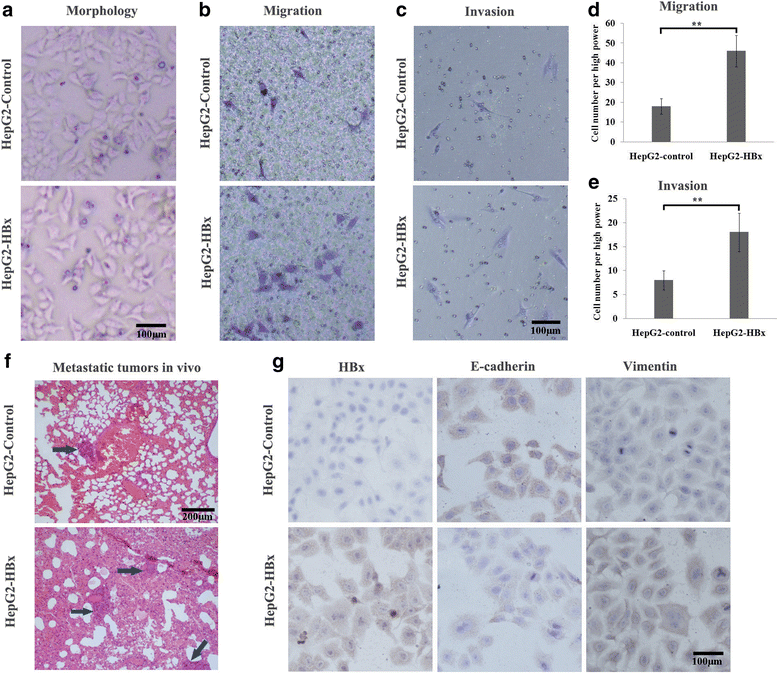Hepatitis B virus x protein induces epithelial-mesenchymal transition of hepatocellular carcinoma cells by regulating long non-coding RNA
- PMID: 29258558
- PMCID: PMC5735895
- DOI: 10.1186/s12985-017-0903-5
Hepatitis B virus x protein induces epithelial-mesenchymal transition of hepatocellular carcinoma cells by regulating long non-coding RNA
Abstract
Background: It has been widely accepted that hepatitis B virus X protein (HBx) plays an important role in hepatocellular carcinoma (HCC). This study aimed to explore the function of long non-coding RNAs (lncRNAs) in the epithelial-mesenchymal transition (EMT) induced by HBx.
Methods: The association between HBx and EMT markers was detected using immunohistochemistry in HCC tissues. The effect of HBx on HCC EMT was assessed through morphological analysis, transwell assay, metastatic in vivo study and detection of EMT markers. LncRNA microarray was used to screen the differently expressed lncRNAs. Small interfering RNA and Western blot were used to analyse the function and mechanism of the locked lncRNA.
Results: HBx was negatively correlated with the epithelial marker E-cadherin but positively correlated with the mesenchymal marker vimentin in HCC tissues. HBx induced the mesenchymal phenotype and improved the metastatic ability of HCC cells. Meanwhile, HBx down-regulated E-cadherin, whereas it up-regulated vimentin. In HCC cells, HBx altered the expression of 2002 lncRNAs by more than 2-fold. One of them was ZEB2-AS1. Inhibition of ZEB2-AS1 can compensate for the EMT phenotype and reverse the expression of EMT markers regulated by HBx. Additionally, HBx affected the Wnt signalling pathway.
Conclusions: HBx promotes HCC cell metastasis by inducing EMT, which is at least partly mediated by lncRNAs.
Keywords: Epithelial-mesenchymal transition; Hepatitis B virus x protein; Hepatocellular carcinoma; Long non-coding RNA; Metastasis.
Conflict of interest statement
Ethics approval and consent to participate
All patients gave their informed consent prior to their inclusion in the study. This study was approved by the ethics committee of Harbin Medical University (reference numbers: HMUIRB20130089). This study was carried out in accordance with the National Institutes of Health guide for the care and use of Laboratory animals (NIH Publications No. 8023, revised 1978).
Consent for publication
Not applicable.
Competing interests
The authors declare that they have no competing interests.
Publisher’s Note
Springer Nature remains neutral with regard to jurisdictional claims in published maps and institutional affiliations.
Figures




Similar articles
-
Hepatitis B virus X protein (HBx)-related long noncoding RNA (lncRNA) down-regulated expression by HBx (Dreh) inhibits hepatocellular carcinoma metastasis by targeting the intermediate filament protein vimentin.Hepatology. 2013 May;57(5):1882-92. doi: 10.1002/hep.26195. Hepatology. 2013. PMID: 23239537
-
Linc00152 promotes cancer progression in hepatitis B virus-associated hepatocellular carcinoma.Biomed Pharmacother. 2017 Jun;90:100-108. doi: 10.1016/j.biopha.2017.03.031. Epub 2017 Mar 24. Biomed Pharmacother. 2017. PMID: 28343069
-
Overexpression of the long non-coding RNA SPRY4-IT1 promotes tumor cell proliferation and invasion by activating EZH2 in hepatocellular carcinoma.Biomed Pharmacother. 2017 Jan;85:348-354. doi: 10.1016/j.biopha.2016.11.035. Epub 2016 Nov 28. Biomed Pharmacother. 2017. PMID: 27899259
-
The role of long non-coding RNAs in hepatitis B virus-related hepatocellular carcinoma.Virus Res. 2016 Jan 2;212:103-13. doi: 10.1016/j.virusres.2015.07.025. Epub 2015 Jul 31. Virus Res. 2016. PMID: 26239319 Review.
-
Hepatitis B virus X protein-mediated non-coding RNA aberrations in the development of human hepatocellular carcinoma.Exp Mol Med. 2017 Feb 10;49(2):e293. doi: 10.1038/emm.2016.177. Exp Mol Med. 2017. PMID: 28186085 Free PMC article. Review.
Cited by
-
LncRNA SAMD12-AS1 promotes cell proliferation and inhibits apoptosis by interacting with NPM1.Sci Rep. 2019 Aug 12;9(1):11593. doi: 10.1038/s41598-019-48116-1. Sci Rep. 2019. PMID: 31406141 Free PMC article.
-
A 9‑lncRNA risk score system for predicting the prognosis of patients with hepatitis B virus‑positive hepatocellular carcinoma.Mol Med Rep. 2019 Jul;20(1):573-583. doi: 10.3892/mmr.2019.10262. Epub 2019 May 22. Mol Med Rep. 2019. PMID: 31115573 Free PMC article.
-
The Malignant Transformation of Viral Hepatitis to Hepatocellular Carcinoma: Mechanisms and Interventions.MedComm (2020). 2025 Mar 8;6(3):e70121. doi: 10.1002/mco2.70121. eCollection 2025 Mar. MedComm (2020). 2025. PMID: 40060195 Free PMC article. Review.
-
TRERNA1 upregulation mediated by HBx promotes sorafenib resistance and cell proliferation in HCC via targeting NRAS by sponging miR-22-3p.Mol Ther. 2021 Aug 4;29(8):2601-2616. doi: 10.1016/j.ymthe.2021.04.011. Epub 2021 Apr 9. Mol Ther. 2021. PMID: 33839325 Free PMC article.
-
Epithelial Mesenchymal and Endothelial Mesenchymal Transitions in Hepatocellular Carcinoma: A Review.Biomed Res Int. 2019 Sep 29;2019:2962580. doi: 10.1155/2019/2962580. eCollection 2019. Biomed Res Int. 2019. PMID: 31781608 Free PMC article. Review.
References
-
- Nanashima A, et al. Clinicopathological characteristics of patients with hepatocellular carcinoma after hepatectomy: relationship with status of viral hepatitis. J SurgOncol. 2007;96(6):487–492. - PubMed
-
- Tanaka K, et al. Clinical characteristics and surgical outcome in hepatocellular carcinoma without hepatitis B virus surface antigen or hepatitis C virus antibody. Ann SurgOncol. 2007;14(3):1170–1181. - PubMed
MeSH terms
Substances
LinkOut - more resources
Full Text Sources
Other Literature Sources
Medical
Research Materials
Miscellaneous

